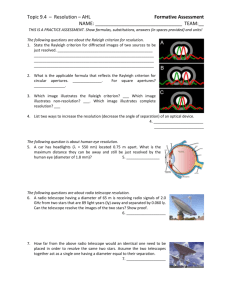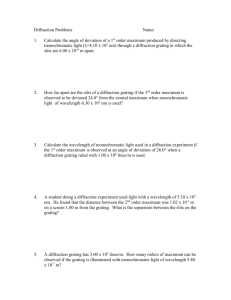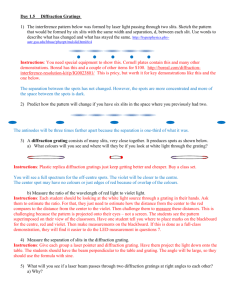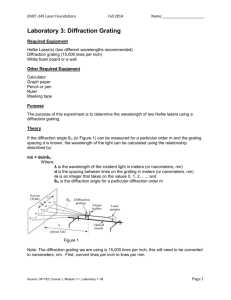Wavelength measurement through the use of a diffraction grating
advertisement
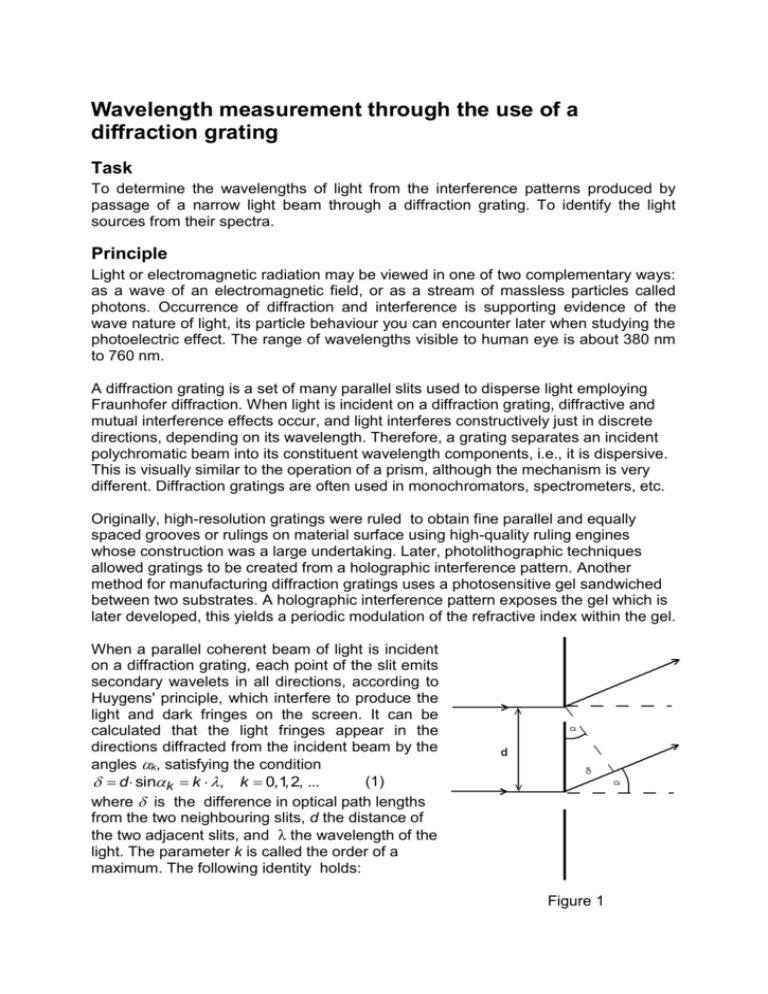
Wavelength measurement through the use of a diffraction grating Task To determine the wavelengths of light from the interference patterns produced by passage of a narrow light beam through a diffraction grating. To identify the light sources from their spectra. Principle Light or electromagnetic radiation may be viewed in one of two complementary ways: as a wave of an electromagnetic field, or as a stream of massless particles called photons. Occurrence of diffraction and interference is supporting evidence of the wave nature of light, its particle behaviour you can encounter later when studying the photoelectric effect. The range of wavelengths visible to human eye is about 380 nm to 760 nm. A diffraction grating is a set of many parallel slits used to disperse light employing Fraunhofer diffraction. When light is incident on a diffraction grating, diffractive and mutual interference effects occur, and light interferes constructively just in discrete directions, depending on its wavelength. Therefore, a grating separates an incident polychromatic beam into its constituent wavelength components, i.e., it is dispersive. This is visually similar to the operation of a prism, although the mechanism is very different. Diffraction gratings are often used in monochromators, spectrometers, etc. Originally, high-resolution gratings were ruled to obtain fine parallel and equally spaced grooves or rulings on material surface using high-quality ruling engines whose construction was a large undertaking. Later, photolithographic techniques allowed gratings to be created from a holographic interference pattern. Another method for manufacturing diffraction gratings uses a photosensitive gel sandwiched between two substrates. A holographic interference pattern exposes the gel which is later developed, this yields a periodic modulation of the refractive index within the gel. When a parallel coherent beam of light is incident on a diffraction grating, each point of the slit emits secondary wavelets in all directions, according to Huygens' principle, which interfere to produce the light and dark fringes on the screen. It can be calculated that the light fringes appear in the directions diffracted from the incident beam by the angles k, satisfying the condition (1) d sin k k , k 0,1, 2, ... where is the difference in optical path lengths from the two neighbouring slits, d the distance of the two adjacent slits, and λ the wavelength of the light. The parameter k is called the order of a maximum. The following identity holds: Figure 1 sin k tan k 1 tan 2 k . (2) If bk is the distance of k-maximum from 0-maximum on the screen placed in the distance a from the grating, it follows (see Fig. 3): b tg k a (3) Combining (1), (2), and (3) we finally obtain bk d b k a 1 k a 2 d a k 1 bk 2 (4) Spectral lamps are filament-electrode gas discharge lamps with low internal pressure As the light is emitted when an atom returns from its excited state to a lower excited state or the ground state, the produced spectra are characteristic for a rare gas or a metal vapour which the spectral lamps contains. Figure 2 Equipment power supply for spectral lamps spectral low-pressure lamps Cd, He, Na, Zn, and Hg, with housings mercury high pressure lamp 80 W, lamp holder on stem diffraction grating, 600 lines/mm on stem collimator screen with line scale free standing triangular optical rail, 1 m rail carriers with holders, 4 pcs measuring tape, 2 m table of elements spectra Set-up and procedure The experimental set-up is as shown in Fig. 2 and 3. Figure 3 1) Set up the experiment following the Fig. 3. L is the light source, C is the collimator, G the diffraction grating, S the screen with a line scale. An optical collimator consists of a tube containing a convex lens at one end and an adjustable slit at the other, the slit being in the focal. It collimates a diverging light beam from a point source to a parallel beam. 2) Switch on the lamp. The full intensity of the radiation will be obtained after a few minutes of heating-up the lamp. 3) Set such a distance from the light source to the collimator to obtain intense and narrow light strip in the middle of the grating. 4) Adjust the screen, measure the distance a and read the bk values (distances of separate maxima from zero-maximum in the middle) for all the maxima obtained. Fill them in the table. Use both the maxima on the left and right sides of the screen, optionally repeat the measurement for several distances of the screen a. 5) Calculate the wavelengths using the formula (4), for each spectral line (colour) find the mean value of the wavelength and try to identify the source using the table of elements spectra. 6) Repeat the whole measurement for at least one other light source.




